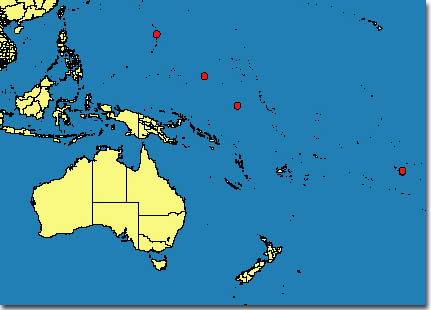 |
 |
||
|
|
|||
| Diagnosis | Encarsia nigricephala Dozier |
|||||||||||||
| Species group | ||||||||||||||
| Distribution | ||||||||||||||
| Host | ||||||||||||||
| Comments | ||||||||||||||
| Illustrations | ||||||||||||||
| DNA | ||||||||||||||
Encarsia nigricephala Dozier, 1937: 129. Holotype female, Puerto Rico, Mayaguez, 12.ii.1936 (H.L. Dozier), ex Bemisia euphorbiae (?tabaci) on low backyard plant (USNM, type no 51607). Encarsia nigricephala: Polaszek et al., 1992: 386. |
||||||||||||||
Diagnosis |
FemaleColourMostly yellow, head, pronotum and mesoscutal midlobe (except posteriorly) dark brown. Remainder of mesosoma yellow, gaster slightly darkened. Fore wing hyaline with bare area near leading edge. Antenna yellow, apical segments darkened. MorphologyClava 3-segmented. Pedicel distinctly longer than F1 (1.64-1.92). F1 shorter than F2 (0.63-0.82) and F3 (0.70-0.78). Mid lobe of mesoscutum with 4 setae. Scutellar sensilla widely separated (approximately 6 x the width of a sensillum). Distance between anterior pair of scutellar setae larger than between posterior pair. Fore wing 2.8-2.9 x as long as wide. Marginal fringe 0.49-0.57 x as long as wing width. Tarsus of middle leg 4-segmented. Apical spur of middle tibia slightly longer than half the length of the basal tarsal segment (0.63-0.65). Ovipositor slightly shorter than or equal to middle tibia (0.85-1.00) and 1.03-1.07 x the length of the clava. Third valvula 0.67-0.68 x as long as second valvifer. |
|||||||||||||
Species
|
Placed in E. cubensis-group by Polaszek et al. (1992). |
|||||||||||||
Distribution
|
 Click here for material examined window. |
|||||||||||||
Host |
B. tabaci (Gennadius). The following additional hosts have been recorded (Polaszek et al., 1999): Trialeurodes abulitonius (Haldeman), T. floridensis (Quaintance), T. vaporariorum (Westwood). |
|||||||||||||
Comments |
The dark head and mesoscutum in combination with the bare area of the fore wing characterize this species and make it distinguishable from the other Encarsia species treated here. |
|||||||||||||
Illustrations |
|
|||||||||||||
DNA
|
28S-D2 rDNA: GenBank Accession Code: AF254246. |
|||||||||||||
| © Copyright 2001, CSIRO Australia |
| [webmaster - February 2001] |
| Use of this web site and information available from it is subject to our |
| Legal Notice and Disclaimer |